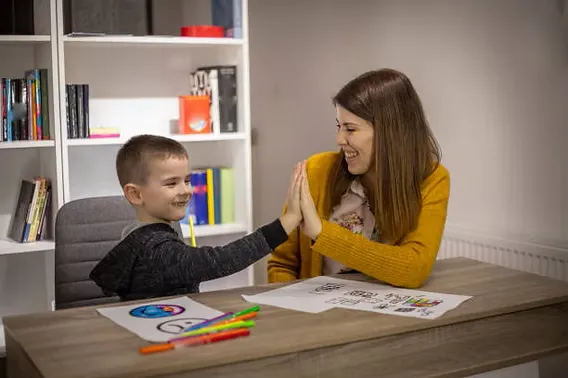Harmony in
Neurodiversity
THE BLOG
Welcome to Harmony in Neurodiversity, a blog dedicated to exploring the profound impact of music and positive parenting strategies on the lives of neurodivergent individuals. Join Samantha, a board-certified Neurologic Music Therapy fellow and a passionate Positive Discipline Parent Educator, as she shares her expertise in leveraging the power of music and effective parenting approaches to support and empower neurodiverse communities.
In her blog posts, Samantha delves into the intricate connections between music and the brain. She explores how specific musical elements and interventions can enhance cognitive functions, regulate emotions, improve communication, and promote social interaction among neurodivergent individuals. Through insightful articles and case studies, she demonstrates how rhythm, melody, and lyrics can serve as powerful tools for therapeutic interventions, fostering growth and self-expression.
Positive Discipline Parenting Strategies:
Drawing from her expertise as a Positive Discipline Parent Educator, Samantha sheds light on nurturing positive relationships between parents and neurodivergent children. Her blog offers practical advice, evidence-based strategies, and real-life anecdotes that empower parents and caregivers to cultivate respectful, encouraging, and effective parenting techniques. From setting clear boundaries to fostering a supportive environment, Samantha guides readers in navigating the challenges and joys of parenting neurodiverse children.
Exploring Intersectionality:
Samantha doesn't limit her discussions to singular approaches. Instead, she delves into the intersectionality of Neurologic Music Therapy and Positive Discipline Parenting, illustrating how these methodologies complement each other. Through her insightful content, she showcases how the harmonious integration of music-based interventions and positive parenting strategies can create holistic support systems for neurodivergent individuals, promoting their well-being and personal growth.
Community Engagement and Resources:
Additionally, Samantha fosters a vibrant online community where readers can engage, share experiences, and seek advice. She curates a wealth of resources, including recommended readings, workshops, and practical tools, empowering her audience to implement valuable insights into their lives effectively.

Homeschooling A Kid With Autism or ADHD: A Practical, Flexible Guide For Real Families
If school is leaving your autistic or ADHD child overwhelmed, discouraged, or simply not learning much, you are not alone. Many families are choosing homeschool because it lets them tailor learning to a child’s needs, energy, and interests.
Below is a straightforward guide drawn from a conversation on episode 126 of the Every Brain is Different podcast with writer and homeschool parent Karen Kossow, plus my own lived experience as a neurodivergent mom.
You will find what homeschool can look like, who it helps most, and how to get started without burning out.
Why Homeschooling Can Work So Well for Neurodivergent Kids
1. You can separate academics from social demands
In a traditional classroom, kids are expected to read, write, collaborate, and navigate noisy social dynamics all at once. Many autistic and ADHD learners do better when you teach skills in separate contexts. Do math when the brain is fresh. Practice friendship skills later in low-pressure settings. This reduces overload and preserves dignity.
2. You avoid the sensory chaos of classrooms
Buzzing lights, chairs scraping, pencil sharpeners, whispering, and constant movement are a lot. Pulling learning into calmer spaces often removes half the struggle.
3. You protect energy for the whole family
Homeschool means no morning rush and fewer behavior spirals from pushing through a day that is not built for your child. Your child is always learning, even when hiding under a blanket or building in Minecraft, and you can lean into that without constant battles.
4. You gain real flexibility
Some kids thrive with a nurturing teacher, and some do not. Homeschool gives you options if a teacher fit tanks a school year, and it lets you pivot quickly instead of waiting months for change.
Two Common Homeschool Paths Parents Ask About
1. Public school at home
In Idaho, the Idaho Home Learning Academy is a district-run option. Kids can have a 504 or IEP, receive speech or OT over Zoom, and must meet state standards and testing. This is a legally public school done at home, not traditional homeschool.
2. Traditional homeschool
Families set their own curriculum and do not register or test with the state in Idaho. You are free to individualize everything. Requirements differ by state, so always check your local rules.
What Learning Can Look Like at Home
Short, focused lessons with plenty of regulation breaks. One kid gets “mom time” while the other rests or hyper focuses on something independent, then you switch.
Tools are normal. Multiplication charts, calculators, and AI planning helpers let kids access content while you build skills at a humane pace. This is especially helpful for dyscalculia, dysgraphia, and processing differences.
Progress without the test pressure cooker. Standardized tests often clash with child development and elevate everyone’s stress. Homeschool lets you track growth through work samples, projects, and real function.
Socialization, Community, and Secular Options
Homeschool is not only for religious families. Many groups are secular and widely neurodivergent. Parents choose it because school systems are not meeting their kids’ needs, not to avoid peers. You can customize your community through pods, clubs, classes, and interest groups that your child actually enjoys.
A Quick Start Plan for Overwhelmed Parents
1. Define your why
Pick the top two pain points. Sensory overload. Homework meltdowns. Teacher fit. Your why guides every choice. If homework shaming or “fun Friday” rewards are tanking your child’s week, that is a clear signal to change the setup.
2. Start tiny
Choose one easy-win subject. Many families start with math if there is a program their child tolerates, then layer in reading or writing later. Keep lessons short and predictable.
3. Protect regulation
Schedule snacks, movement, and quiet time before you expect hard thinking. If a task goes sideways, reset rather than push through.
4. Use accommodations on purpose
Visuals, audiobooks, speech-to-text, multiplication charts, calculators, and timers are all fair game while skills develop.
5. Add social on your terms
One club, one playdate, or one co-op day a week in a calmer environment beats five overloaded days.
6. Revisit quarterly
If a mix of part-time school and home is working, keep it. If not, pivot. There are no points for doing it the hard way.
Homeschooling is not about replicating school at your kitchen table. It is about giving your neurodivergent child space to learn in ways that protect their nervous system and your family’s energy. Start small. Customize as you go. Your child can learn, and you can build a life that actually works.
For more tips, listen to episode 126 of the Every Brain is Different podcast.


